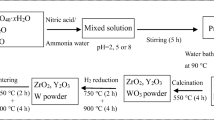Conclusions
-
1.
Fiber-reinforced binary and multicomponent cobalt-base powder alloys have a strong propensity to intermetallic compound formation at their matrix/fiber interfaces and in their tungsten fibers. The probability of VT7 alloy fiber recrystallization is 25% at 1300°C and more than 90% at 1400°C in binary mixtures and about 50% at 1300°C in multicomponent mixtures.
-
2.
The more complex the alloy composition, the greater is the probability of recrystallization — the change in the structure of tungsten fibers having the most deleterious effect on their strength.
-
3.
Cobalt-base alloys show promise as matrices of heat-resisting metallic materials reinforced with tungsten and tungsten alloy fibers, and more investigational work should be conducted upon them.
Similar content being viewed by others
Literature cited
K. M. Rybal'chenko, L. M. Ustinov, and V. I. Bakarinova, “Physicochemical reactions on the interfaces in fiber composites with metallic matrices,” Fiz. Khim. Obrab. Mater., No. 2, 120–127 (1973).
B. A. Klypin, A. M. Maslov, and S. B. Maslenkov, “Fiber reinforcement of heat-resisting alloys,” Metalloved. Term. Obrab. Met., No. 8, 2–6 (1971).
K. I. Portnoi et al., “Use of titanium nitride as a diffusion barrier in nickel-base composite materials,” Fiz. Khim. Obrab. Mater., No. 3, 122–126 (1973).
V. E. Panin et al., “Directional matrix alloying as a means of increasing the thermal stability of nickel-base composite materials reinforced with tungsten and molybdenum fibers,” in: Structure and Properties of Heat-Resisting Metallic Materials [in Russian] (1973), pp. 103–111.
A. W. H. Morris and A. Burwood-Smith, “Some properties of a fiber reinforced nickel-base alloy,” Fibre Sci. Technol.,3, No. 1, 53–78 (1970).
F. P. Banas, V. V. Gaiduk, B. S. Natapov, et al., “Composite materials consisting of an 80% Ni-20% Cr alloy and molybdenum or tungsten,” Metalloved. Term. Obrab. Met., No. 8, 6–11 (1971).
V. S. Mirotvorskii and A. A. Ol'shevskii, “Reactions of thoriated tungsten fibers with iron-base powder matrices,” Poroshk. Metall., No. 7, 46–52 (1976).
A. A. Ol'shevskii and V. S. Mirotvorskii, “Recrystallization of VT-7 tungsten in powder composites,” Metalloved. Term. Obrab. Met., No. 11, 21–24 (1975).
L. Brautman and R. Crock (editors), Modern Composite Materials [Russian translation], Mir, Moscow (1970).
M. Hansen and K. P. Anderko, Constitution of Binary Alloys, McGraw-Hill, New York (1957).
Constitution Diagrams of Metallic Systems [in Russian], Vol. 15, VINITI, Moscow (1969), pp. 247 and 257.
D. W. Petrasek and I. W. Weeton, Trans. Metall. Soc. AIME,230, Aug., 1964.
T. Montelbano, I. Brett, et al., “Nickel induced recrystallization of doped tungsten,” Trans. Metall. Soc. AIME,242, Sept., 1968.
Author information
Authors and Affiliations
Additional information
Translated from Poroshkovaya Metallurgiya, No. 7(187), pp. 57–64, July, 1978.
Rights and permissions
About this article
Cite this article
Mirotvorskii, V.S., Ol'shevskii, A.A. Reactions of tungsten fibers with cobalt-base matrices. Powder Metall Met Ceram 17, 536–541 (1978). https://doi.org/10.1007/BF00791930
Received:
Issue Date:
DOI: https://doi.org/10.1007/BF00791930




